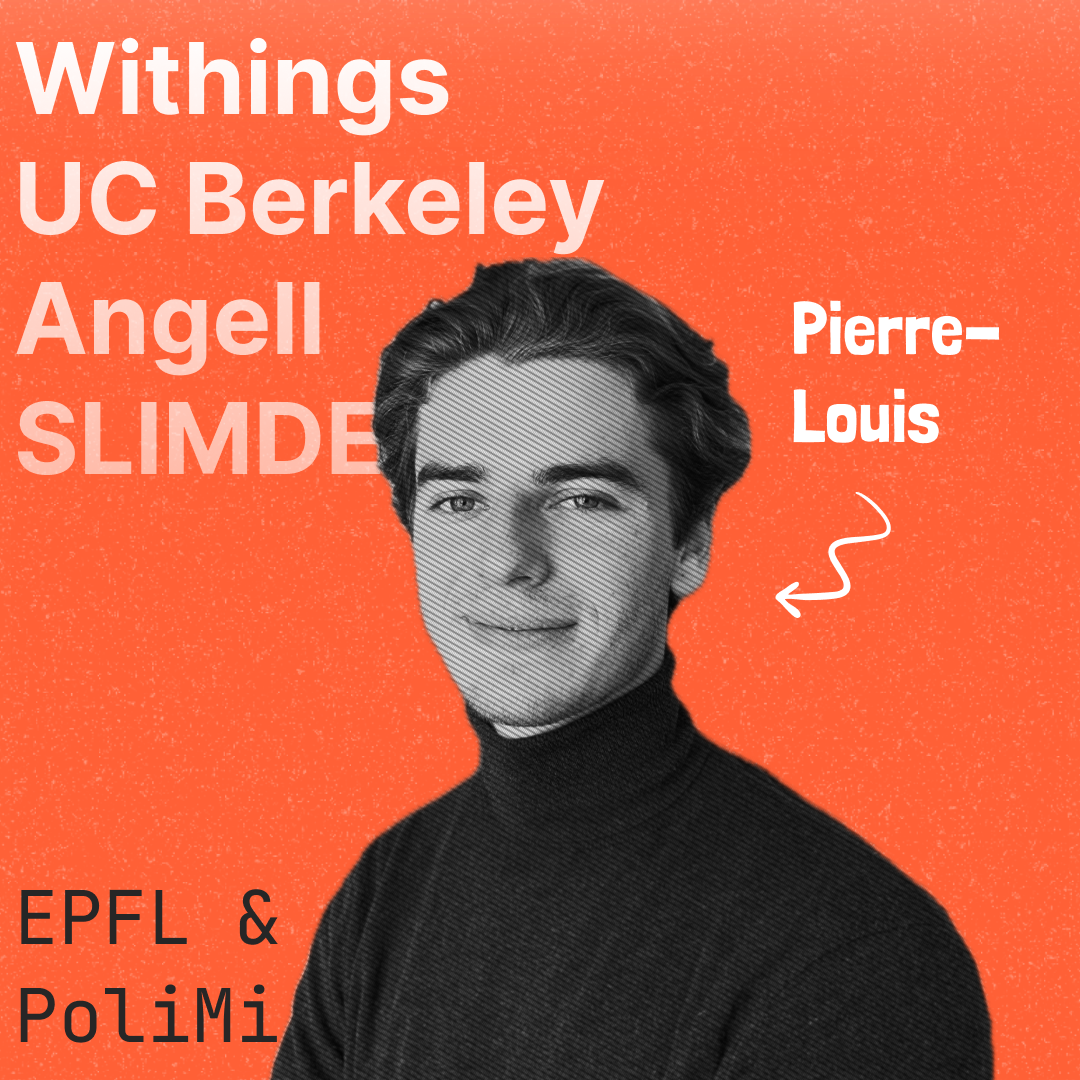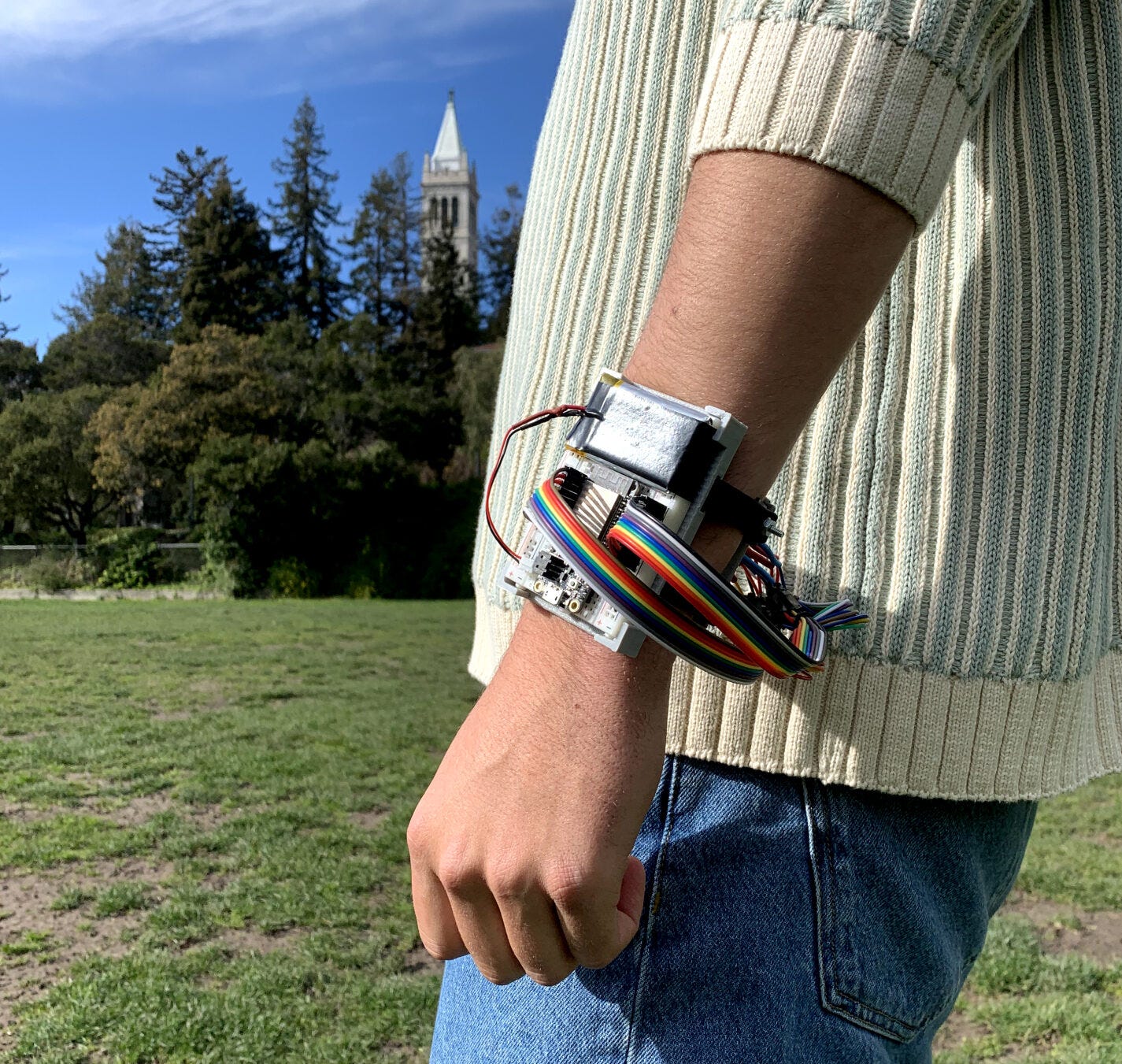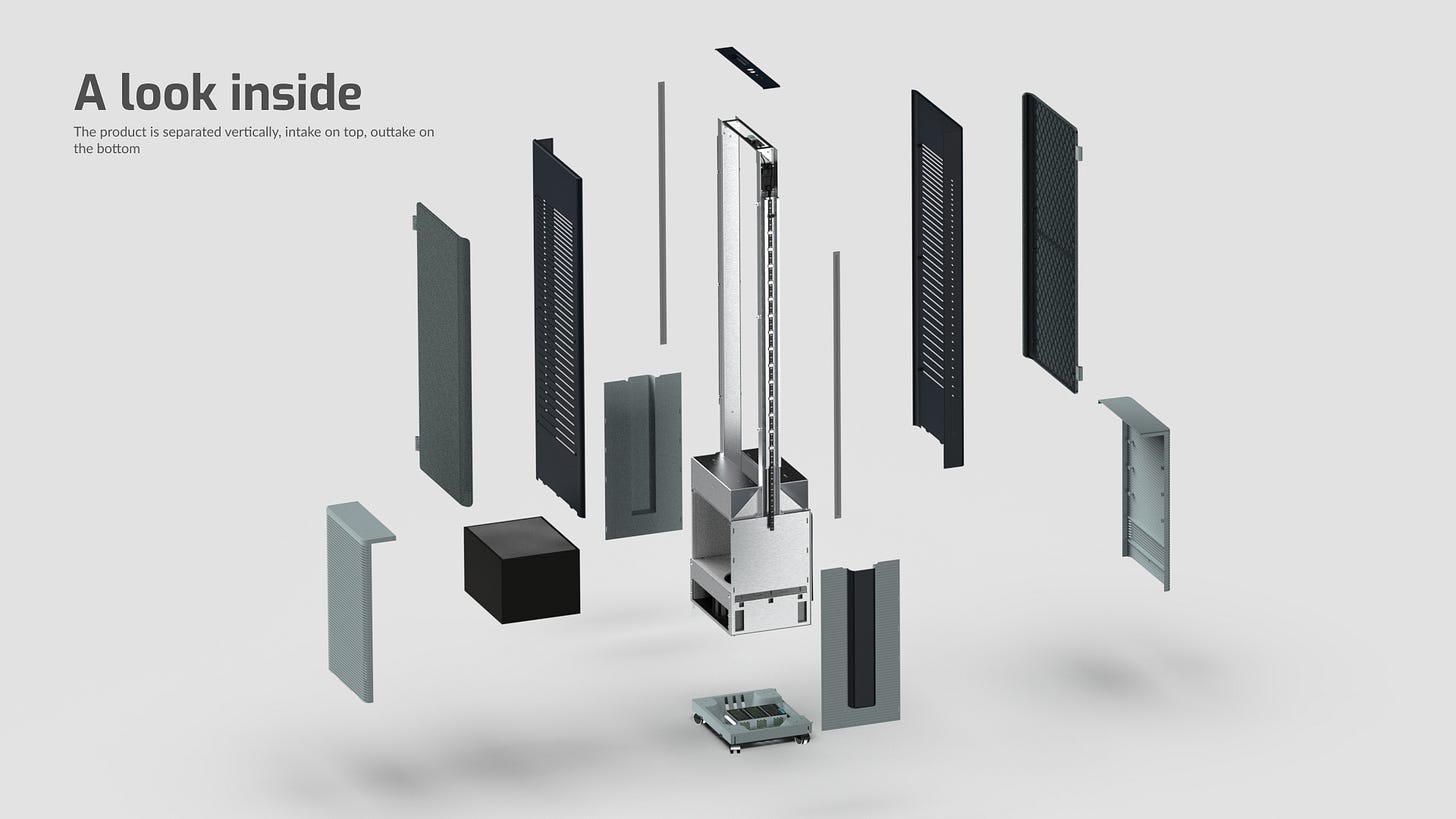Berkeley, Withings and leaving engineering for design. Meet Pierre-Louis.
Sick of theoretical ML exercises, Pierre-Louis questioned his micro-engineering studies. Despite others' expectations, he switched to design, which led to great experiences at Berkeley and Withings.
Studies: Thesis @ UC Berkeley ‘23, MSc Design & Engineering @ Politecnico di Milano ‘22, BSc Micro-Engineering @ EPFL ‘20
Experiences: Angell Mobility, Withings, SLIMDESIGN
Origin: France
Links: LinkedIn, Portfolio
Note: Make sure to check out Pierre-Louis’ portfolio, where you can see all his product design work!
Growing up and discovering product design
Where did you grow up and what drew you to design?
I’m French and come from a small city in the south of France called Rodez. That’s where I spent half of my life until I turned 13 and my parents decided to completely drop their careers and move to Morocco. We moved there because of their new business - they discovered a passion for renovating old houses. My mother was an architect really into design and my dad was interested in entrepreneurship. Together they decided to buy some old riads in Morocco, renovate them, and start renting rooms, turning them into guest houses.
I think I was always interested in design because when I was young, my mom had a furniture store in my hometown. I remember she would pick me up from school and I would wait in the shop for hours, browsing the shelves, looking at everything, trying out the couches and lamps. My house was also always full of interesting design pieces and furniture that my mom would find at flea markets every weekend. So design was always part of my life - I always had this sense of aesthetic and creative vision, even though I wasn’t practicing design myself as a kid. As a teenager though, I started using software to make graphic designs and infographics.
What made you choose EPFL and the micro-engineering section?
Moving to Morocco was really eye-opening. I went from being immersed only in French culture to this international environment with a new culture, religion, traditions, and people speaking Spanish, English, Arabic. I was really fulfilled by this international lifestyle I was discovering. So for university, I decided I wasn’t done with this and wanted a more international student environment rather than going back to France. I was considering places like TU Delft, EPFL, and schools in the UK, but ended up choosing EPFL because of the academic recognition, international environment, broad course offerings, and the amazing campus setting close to the mountains since I like skiing.
I chose the micro-engineering section because I had always been interested in hardware and as a kid, I saw the engineering profession as someone who makes robots. But I also wasn’t completely sure what I wanted to do, and micro-engineering felt like the most generic section since it had classes in computer science, electronics, material science, chemistry, life science. Although it was hard with a lot of classes for few credits, it was super interesting and really taught me engineering in a broad, holistic way.
Making the difficult choice - pursuing your passion rather than following the herd
It was a big decision to switch from engineering at EPFL and instead go for design at Politecnico di Milano. How did this happen?
While at EPFL, design was completely out of the picture for me. I thought I wanted to do data science and machine learning like everyone else. So I did an exchange year in Lisbon taking classes only in artificial intelligence, machine learning, robotics. But during the winter exam session, after doing so many theoretical exercises, I was questioning myself, suffering because I didn’t feel like I was liking it. I called my dad and told him I think I just want to do design. He said he would still be proud of me studying design, that it’s about how happy I am in what I do, not what I study.
That was the click for me. I started looking for master’s degrees in design that would accept someone with an engineering background. There were a few options in Europe, but the only two that didn’t require a design portfolio, which I didn’t have, were Politecnico di Milano and Aalto University in Finland. I decided to aim for Politecnico since it was one of the best design schools and a recognized scientific institution. I applied and got in for the MSc in Design & Engineering, which brings together 75% design students and 25% engineering students to work on developing hardware products.
What were the most valuable learnings from the program in Milan?
The program was really hands-on and project-oriented. Every semester we had a new company come and give us a brief, like “we need a machine that sanitizes the environment in private spaces open to the public”. Then we had to figure out what to sanitize, how to do it, where, what technology to use, and implement it into a product that’s functional and aesthetically pleasing while considering user experience, design and interaction. It’s a long iterative process, but exactly how it’s done in industry for real products.
I learned the design process, which I was missing before. At EPFL, you learn to quickly find a solution to a problem with hardware and that’s it. At Politecnico, I learned to take the good path, not the straight one. Design is an iterative process that takes a while with many considerations. I also learned I didn’t need to be a good sketcher or 3D modeler myself, because in a group you have designers doing that part. As the engineer, I would coordinate component selection, product form factor, and feasibility - taking the designer’s ideas and making them real. That’s the job of a product design engineer, being the link between the two worlds.
If there’s students that want to learn design, can they do it on their own or should they take a degree like you?
Of course you can learn it on your own, but I would highly recommend doing at least an online class on design thinking, product design and development, or user experience design. Try to understand the process behind it, because it’s not something that’s set in stone. But there is a way of thinking, of approaching projects, getting feedback, understanding human interaction design and how a person will interact with a feature or object. It’s not even about learning how to do it, but just knowing it exists and taking into consideration all the factors.
Master’s thesis in the US
Tell me about your master’s thesis experience in UC Berkeley in California. How did you find and apply for it?
For my master’s thesis, I called one of my professors at Politecnico who was my thesis advisor and he said I could find a project in any lab I wanted, it didn’t have to be at the school.
I started emailing professors in California because I wanted a last chance to spend a semester abroad and experience the American campus lifestyle. I got a product design project in a lab at UC Berkeley with a mechanical engineering professor working on micro actuators and sensors. They had developed a new cutting-edge technology for piezoelectric micro actuation that would be interesting for virtual reality applications.
Basically, the little vibrators in your phone that provide haptic feedback - they had found a way to make an actuator vibrate in only one direction without spreading vibration waves to the environment. This is interesting because you can develop a matrix of vibrators to vibrate at a specific point on the skin, replicating the sensation of touching a texture in VR.
When I arrived, they wanted me to take the actuator technology and build a wearable proof of concept to test it. In design, you always want to find a cool story to tell about a project. I felt like improving some billionaire’s VR gaming experience wasn’t a great story. I wanted to do something more social.
So I decided to build the product as the lab required, but instead of focusing the research on VR gaming, I researched if it would be an interesting device for blind people to receive navigation instructions on their wrist. It was a wristband with an array of actuators that I could send commands to via Bluetooth to activate vibrations in patterns, like a movement going forward to indicate “move forward”, or to the left or right to turn.
How did the US experience compare to Europe? Would you want to go back?
It was so nice, I really liked it. I think the main strength is the teaching - the professors have patents, so many research papers, high h-indexes, some have startups, some are famous, some have Nobel prizes. It’s an environment where all these incredibly smart people from all over the world come together to teach in one place.
The culture and mindset is also different. When you meet all these smart Berkeley people, it’s very interesting. I think I’d like to work in California at some point in my life, I really enjoyed the experience.
Gaining industry experience through internships
You also did many internships throughout your studies such as at the SLIMDESIGN design studio and others. How did you find them?
To find the internships, I literally just sat down for two weeks over Christmas break, Googling “product design agency” plus the name of cities I liked - Amsterdam, Copenhagen, Berlin, Milan, Paris, London. I made a list, wrote a short email with my portfolio and CV, and sent it to like 150 companies. I got two opportunities in design studios 100 meters apart in Amsterdam. Having the engineering degree really made me stand out, but you also need good projects in your portfolio showing your process. The degree gives you tools, but you need to show you can apply them.
After the US, you went to work at Withings. What drew you to the company and what were your main takeaways?
After my thesis, I did another internship at Withings, a company in Paris that makes consumer health electronics like smart watches and scales. I wanted to work in a less technical role, more on the managerial side, so I did product management there.
I was drawn to Withings because it’s the biggest company in France for high-tech consumer electronics. They have a big R&D department, the most patents on smart scales, and were the second company after Apple to release a watch with real-time heart rate monitoring. In Paris there aren’t many companies making products like this.
As a product manager, I was like the head of the project for developing a product, speaking with the designers, engineers, factory, organizing everything to manage the product lifecycle. It was really business-oriented with a lot of marketing and dealing with regulations. I learned a more holistic view of product development, dealing with the entire scope and lifecycle rather than solving one specific technical problem. It was fulfilling and stimulating, but I was also a bit bored by some daily tasks, especially the regulations and market research parts.
Current role and ambitions
What are you doing now and what are your goals for the future?
Now I’ve been working for a few months at a company in Paris called Angell that makes electric bicycles. I’m in a product development role, kind of in between pure engineering and product management. I’m not spending my whole day on mechanical design, but I still get to do some 3D modeling. I go to the factory every two weeks to meet with the assembly engineers, I test prototypes, build some prototypes, and work on developing future products. It’s very interesting and I think I’ve found my balance between the technical and managerial sides. I’m doing a job I’m really confident in.
For the future, I want to keep working on hardware - I love physical products and materials. As I evolve, I’ll likely take on more responsibilities and work on more managerial topics. In five years, I’ll probably move towards a product manager position. Eventually, I’d like to have my own company, either building my own products or a product development agency making products for other companies. A cool brand or a renowned design agency would be the dream.
Wisdom for students
Looking back, is there anything you would have done differently? What advice would you give to students?
I don’t have regrets because I made the best choices I could with the information I had at the time. One thing is I would have liked to do a gap year between bachelor’s and master’s, but it was during COVID so I felt it would be a waste of time without being able to find a job, travel or internship. So I jumped into the master’s still having some doubts. Taking more time would have let me be more sure.
I think EPFL students should also consider doing their master’s in the US, because technology is so big there. As an engineer in the US, you can earn way more than in Europe and have the chance to work at some of the most influential companies creating the most relevant products. Studying there also gives you OPT (optional practical training), letting you stay and work for 3 years after graduating, which is enough time to pay back loans and get amazing experience.
My advice would be: if you have an idea that’s unconventional, don’t be afraid, don’t underestimate yourself, and just go for it. Even if nobody believes it will work or make sense, if you believe in it, do it. You have to make your own path to achieve your goals and dreams. When I was younger I spent too much time worrying what people thought about my choices. I did my master’s in design at Politecnico di Milano after thriving 4 years at EPFL to become an engineer, the opposite of what people usually do. Some asked if I regretted it, but no, I was pursuing a goal I set for myself that I believed was right. Whatever path you take, you’ll end up where you belong. Life is well done like that.
Closing notes
Hope you enjoyed reading this one! I really related to this one - oftentimes I found myself studying things just because everyone else was doing it. Pierre-Louis’ story really resonated for me in this sense :)
As always, let me know what you think of the blog!





